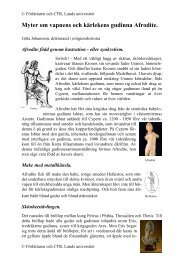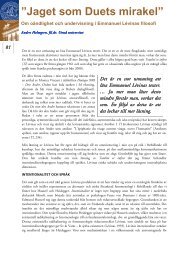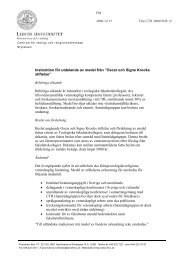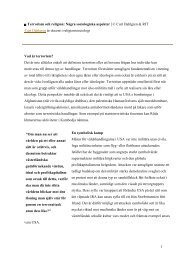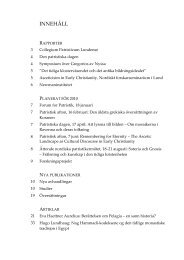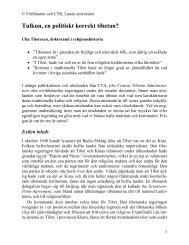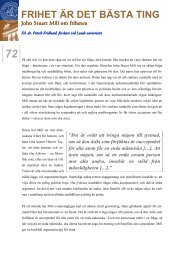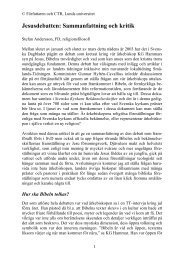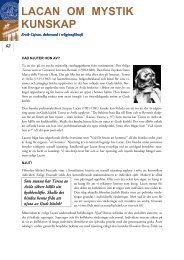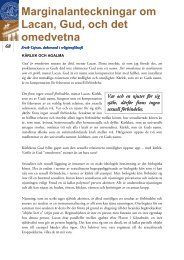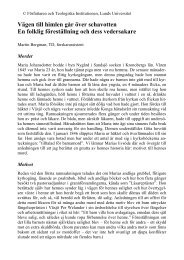Meddelanden 25 (2010) (PDF 2.0 MB - Nytt fönster) - Centrum för ...
Meddelanden 25 (2010) (PDF 2.0 MB - Nytt fönster) - Centrum för ...
Meddelanden 25 (2010) (PDF 2.0 MB - Nytt fönster) - Centrum för ...
Create successful ePaper yourself
Turn your PDF publications into a flip-book with our unique Google optimized e-Paper software.
elieve that Theodore and Horsiesios themselves knew of the codices we now possess<br />
(although that remains possible); rather, their comparable habits of exegesis and<br />
catechesis make it entirely likely that the Nag Hammadi documents could have taken<br />
their surviving form within Christian ascetic society. That could have been the case,<br />
not because Christian ascetics thought like gnostics, but because they could turn the<br />
material to their own use. 30<br />
While I would question the general characterization of the Nag Hammadi<br />
codices as “gnostic” material, I find the analysis intriguing, an effort to<br />
understand similarities rather than accentuate differences.<br />
In fact, those who gathered the texts and fashioned the Nag Hammadi<br />
codices had themselves “recycled” material “according to new patterns.”<br />
When one draws many of the texts out of the Gnostic “ghetto” into which<br />
they have been relegated by virtue of their having been “recycled” into the<br />
Nag Hammadi collection and thus associated with the texts representative of<br />
“biblical demiurgical” traditions, 31 they are seen to better align with other<br />
worlds of thought. The Sentences of Sextus (NHC XII, 1) offers an obvious<br />
case in point. While the overall collection certainly underscores its heterodox<br />
nature, we should remember that individual texts were read by different<br />
people in different ways. One need not always assume that the less heterodox<br />
texts were read in light of the more heterodox texts, and not the other<br />
way round. Wolf-Peter Funk’s discovery of a passage shared in common between<br />
the Teachings of Silvanus and the teachings of Antony, for example, indicates<br />
a common background that precedes the later more sharply divided<br />
camps to which they were eventually relegated. Clearly those who, according<br />
to Funk, drew from a common wisdom tradition, had similar habits of<br />
thinking and exercising curiosity, and one suspects similar habits of living as<br />
well. 32<br />
In bringing this brief series of reflections to an end, I would call your<br />
attention to an article entitled “Antony's Letters and Nag Hammadi Codex I:<br />
Sources of Religious Conflict in Fourth-Century Egypt,” that appeared recently<br />
in the Journal of Early Christian Studies. 33 Taking Michael William’s<br />
notion of the coherence of the individual codices in the Nag Hammadi collection<br />
seriously, the authors, Lance Jenott and Elaine Pagels, explore ideological<br />
themes and emphases common to both the assembled five tractates<br />
that form Nag Hammadi Codex I and the collection of seven letters attributed<br />
to the famous ascetic Antony. They argue that “a fourth-century<br />
30 Rousseau, “The Successors of Pachomius,” 157.<br />
31 Williams, Rethinking “Gnosticism”, 51.<br />
32 Wolf-Peter Funk, “Ein doppelt überliefertes Stück spätägyptischer Weisheit,” ZÄS 103<br />
(1976): 8–21.<br />
33 Lance Jenott and Elaine Pagels, “Antony’s Letters and Nag Hammadi Codex I: Sources<br />
of Religious Conflict in Fourth-Century Egypt,” JECS 18 (<strong>2010</strong>): 557–89.<br />
∙ 69 ∙



